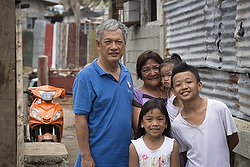TACLOBAN, Philippines (CNS) — Mention the name of Maria Rosevilla Margate and many of the residents of the community known as Barangay 54A nod approvingly. They know exactly where to find her.
People tell stories of her kindness and friendship. Maria and her husband, Emmanuel, have lived in the community just a block from Redemptorist-run Our Lady of Perpetual Help Church since 1983. For years, they say, Maria Margate has helped her neighbors in need.
Just like Nov. 8, the day Typhoon Haiyan made a shambles of much of the central Philippines.
Maria Margate’s effort to shelter dozens of neighbors in her family’s concrete-walled home at the peak of the storm is well-known in the barangay. For that, people are grateful.
She considers her actions nothing extraordinary. “I’m just a good neighbor, maybe,” she told Catholic News Service Feb. 10, seated at a small table in her dining room that is protected only by a tarp.
But her story illustrates the close bonds she has forged in her community and the devout Catholic faith she practices in prayer and attending daily Mass.
She recalled awakening before dawn that day, hearing the wind rising in intensity, driving heavy rain onto the roof of her two-story home.
“I saw the wind is getting stronger and stronger. So I go down and I call all my neighbors. ‘Please come up. Please come up. The wind is getting stronger and stronger.’
“Some of them said we’ll cook our food, we will keep our stuff. I told them, ‘No, it’s not important. The important (thing) is to come up. Please come up.'”
She continued door to door as the waters began to rise. One family, two families, three more. Finally she had to get to safety herself. She thought that as many as 80 people were in the small house.
They first gathered in the dining room on the first floor with a few in an upper bedroom. The roof above the dining room began vibrating in the wailing wind. Realizing it could be torn off at any moment — eventually it was — she ushered everyone upstairs to the bedroom, where a sturdier portion of the roof offered more protection.
With everyone safely inside, Maria Margate wanted to get one more look outside to see what was happening. She opened the door leading to a small terrace across from the bedroom. Maybe one more person was out there who needed help, she thought.
“I saw the water. It was so black. Black water, very, very black. When I pushed (the door) to close again, the water rose up.”
She described what she saw as a vortex, spinning round and round, swallowing everything in its path.
She recalled three surges over the course of about an hour, the final one being the highest — perhaps 15 feet — and the strongest. It caused her home to shudder. It was then she considered the possibility of dying.
“The last word I said was, ‘Lord, thy will be done,’ and I closed my eyes.”
That’s when the flood waters vanished, leaving behind death and destruction.
“I know it was a miracle because outside of our house the water was here,” Maria Margate said, raising her right arm to her chest. “But in our bedroom it was just this high,” she said, pointing to her ankles.
When people finally began emerging, they saw little left of their community. One-story wooden and metal houses had become matchsticks. Only a few taller houses made of stronger materials remained standing, but even they were severely damaged; not one had a roof.
Some of the dead could be seen where the houses once stood.
“When I came down here, I didn’t see any stuff. No clothes. No appliances. But it’s OK because I saved people. It’s only material things.”
She said she was afraid she had developed a phobia: “When there’s a small wind, I tremble.”
She gazed toward the serene bay, then covered her face with her hands. Tears trickled down her cheeks. The churning waters of death were real again.
“Sometimes after the typhoon, I don’t want to remember anything,” she said.

Soon after the storm, the Margates headed to Cebu, much farther inland on Leyte Island and where one of their adult daughters lives. While Cebu was affected by the storm, the damage was much less severe than in Tacloban and surrounding communities.
The Margates returned to Tacloban at the end of January to check on the house and make some minimal repairs. But they plan soon to return to Cebu, where they have rented an apartment and plan to enroll son Anthony, 11, and granddaughter Frances Lhoreigne Margate, 6, in school. Life in Cebu is much more stable, said Emmanuel Margate, who is retired from Eastern Visayas State University, where he taught mechanical engineering for 30 years.
The Margates will keep their house in Tacloban. Emmanuel Margate said he hopes he and his wife can save a little money in the hope of repairing the place they have called home since 1983. But a monthly pension of 11,900 pesos — about $266 — from the university only goes so far.
Two adult daughters who work as nurses in Singapore have been sending money to help with replacing some of the possession their parents lost. Another son is planning to enroll in medical school after recently becoming a registered nurse.
The couple also owns a small home and small coconut farm about 45 minutes from Tacloban. The storm also damaged the farm, uprooting about 80 percent of the coconuts trees they own. One tree smashed into the home there.
Emmanuel Margate said he prefers to focus on rebuilding the farm and leaving behind the noise and crowded conditions of the barangay.
“It’s time to restart our life,” he said.
Maria Margate, however, said she wants to stay in the barangay, where she knows the people and feels welcome. She does not want to abandon her friends and neighbors. She sees signs of normalcy returning as people reassemble their lives. She wants to do the same with them.
“I love this place,” she told CNS.
— By Dennis Sadowski, Catholic News Service.







